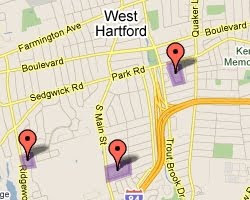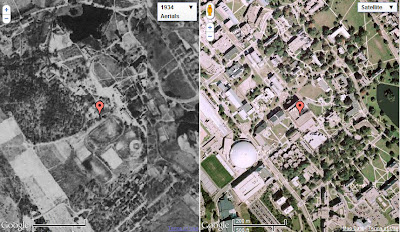Over the past two years, the University of Connecticut Libraries Map and Geographic Information Center – MAGIC has embarked on a number of changes to increase access to data and maps from our collections via our website. Each of these changes have been driven by our users as MAGIC transforms to meet the every changing needs of our users. Using the University of Connecticut’s Academic Plan, the University Libraries Strategic Plan, the Horizon Report, and user feedback for guidance in our effort to improve the overall user experience, several significant changes have taken place which have resulted in increased usage and have fostered new collaborations across the region. Thanks to the efforts to enhance and improve MAGIC’s web presence we have seen a dramatic increase in the number of web users from 51,789 in 2008 to over 460,000 in 2010. Included below are just a few examples of the number of enhancements to the MAGIC website:
Infrastructure for the Future
The past few years the University of Connecticut Libraries have invested heavily in infrastructure to help MAGIC meet the needs of our users. Thanks to the efforts of the Libraries IT Services staff, MAGIC has been able to transition for a 6+ year old web server which included both website content and data to a new server infrastructure that includes MAGIC’s web content while also providing users with downloadable datasets, maps, and aerial photography directly from our recently developed digital archive. The MAGIC digital archive, is a web server that contains all of the full-quality original imagery, maps and data products developed by MAGIC and our collaborators, that is backed up on a regular basis (Hourly) and provides a permanent home for digital content from MAGIC. This new infrastructure has expanded MAGIC’s offerings to enable users to access the highest-quality imagery and maps 24 hours a day, thus enabling users to have unprecedented access to maps and aerial photography images, something that no other academic map collection is able to match!
During this infrastructure migration process, each step has focused on the sustainability of our resources, and as a result some resources that were formerly offered by MAGIC will no longer be available. With a focus on the future, one that includes a variety of operating systems and devices, products that were based on Perl programming (MAGIC’s former data pages by quadrangle, town, and county and other Perl based pages) are being replaced by statewide data offerings available from MAGIC’s GIS Data download page (http://magic.lib.uconn.edu/connecticut_data.html). This migration from Perl based pages is essential for the long-term success of MAGIC as we no longer have programmers available that are proficient in Perl. This change has also enabled us to streamline data offerings and enables us to generate data previews, KML (Google Earth friendly files), and multiple projections for each shapefile to meet the diverse need of our users. This migration was necessary in preparation for migration to an ArcSDE Server (a behind the scenes data management program to manage the 5 Terabytes (and growing) of data available from MAGIC). Over the next year we will also be developing and testing a series of services using the ArcGIS Server platform to enable users to view data and maps via mobile devices.
Collections
The MAGIC Historical Map collection includes the ability to download TIFF versions of each map (georeferenced when possible) directly from our website. The Historical Map Collection at MAGIC is also included on MAGIC’s Flickr site (a popular image and photo sharing site) which enables more users to discover our resources as the maps are readily searchable via a Google Images search and via numerous search engines. This has resulted in a dramatic increase in the use of our Historical Maps (130,913 views of MAGIC’s Flickr maps in 2010).
With an increasingly diverse user population, MAGIC has been utilizing Google Analytics to identify trends in usage of our web content. As an example, keyword searches conducted on MAGIC’s website are analyzed to determine if there are emerging trends/topics and we then use this data to focus our data creation and digitization efforts. This data has been critical to our recent success with obtaining a grant from the National Endowment for the Humanities to co-develop a web book with Trinity College that integrates interactive maps from MAGIC with content (see http://ontheline.trincoll.edu).
To further promote access to MAGIC’s historical aerial photography collection, the aerial photography indexes have been updated to include links to PDF and TIFF images (more coming soon) and these indexes are available in spreadsheet, shapefile, KML, and Map Preview options (see http://magic.lib.uconn.edu/connecticut_data.html#indexes). We are also in the process of creating aerial photography mosaics for the Hartford Region at 20 year increments (when possible) and once these are complete, we will be adding these to MAGIC. In the coming weeks we will also be adding 30+ years of Connecticut coastal infrared aerial photography to this site which will include PDF and TIFF images thanks to a two year collaborative grant project with the Connecticut Department of Environmental Protection.
Mash-ups and KMLs

Making data and maps more user friendly is a key focus of MAGIC’s efforts and because of this need we have created customized Google Map Mash-ups (maps that blend data from multiple sources) for multiple topics. Each of MAGIC’s map mash-ups utilize the Google Maps API to create these custom interfaces and a complete listing of our latest map mash-ups are available on MAGIC’s website at: http://magic.lib.uconn.edu/mash_up/
We have also expanded our data pages to include KML (Google Earth) files when possible as more of our users are turning to Google Maps and Google Earth as there map creation tools. There are numerous classroom applications for using Google Maps and Google Earth and we are happy to work with anyone interested in exploring options for visualizing data for their classes using these tools.
GeoCommons at MAGIC

Over the past year, the former Map Reading Room on Level 4 of the Homer Babbidge Library has been transformed into a collaborative learning environment with the addition of new reconfigurable furniture, 2-46 LCD screens to enable group collaborations with laptops, and a desktop computer with ArcGIS, Adobe Creative Suite, Video Editing, Google Earth and more is also available for public use anytime the Homer Babbidge Library is open. We encourage you to stop by and see this new space!
Internships at MAGIC
Through a collaboration with the Department of Geography, MAGIC offers an internship program for undergraduate students majoring in geography. This internship program allows students to further develop their skills with geospatial data and maps through a hands-on immersive experience at MAGIC that includes digitizing data and maps, developing interactive maps, and more. Special thanks to Dr. Osleeb, Dr. Berentsen, Dr. Cromley, and Dr. Seth for promoting this internship program.
Forthcoming Updates:
Over the next year several updates will be made to provide new services and resources via MAGIC’s website. Included below are some of the projects underway now that will further expand upon our web offerings:
– Connecticut GIS Data Page is being updated to include more KML and Google Map Preview options as well as bundling all our shapefiles for each dataset into one zipped file so users can download NAD 83 and WGS versions of the data as one package. This bundling of the data enables users to create print maps in Connecticut State Plane projections while also providing the shapefile in WGS1984 projection to enable users to quickly generate KML data using ArcGIS and other mapping programs.
– Historical Maps Collection will expand to include more maps, each with TIFF versions available.
– Develop and Test a series of map services using ArcGIS Server 10 to provide more options for viewing aerial imagery, historical maps, and data provided by MAGIC. This server will also enable data and maps from MAGIC to be viewable via the ArcGIS mobile application for iPad, iPhone, Android, and Blackberry devices.
– Developing Map Mash-ups that utilize additional data and maps from MAGIC’s collections.
– Exploring options for enabling users to provide comments on MAGIC’s maps and resources.
– Expand KML offerings to enable users to view more of MAGIC’s data and maps via Google Earth, Google Maps, and Google Fusion Tables.
This is just a few of the exciting things happening at MAGIC. To keep current on the latest events at MAGIC follow our blog, Outside the Neatline, or you can follow us on Twitter, Facebook, and via RSS. Check out our website at: http://magic.lib.uconn.edu
We would also like to recognize the faculty, students and the UConn Libraries IT staff that have assisted us at MAGIC over the past few years to enable us to transform from a map library into a Map and Geographic Information Center. Thanks to their efforts, MAGIC has been recognized by EDUCAUSE, NITLE, NEH, and several of national and regional organizations.










